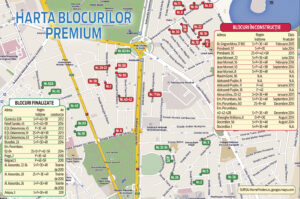When talking about housing affordability, one has to take into account three main variables: the price, the monthly installment and the income level (necessary in order to establish the debt ratio – the percentage of assets provided via debt). Back in August 2013, when the government announced it would use the “First Home” program in order to boost loans in lei, a middle-income family interested in acquiring a 50 m2 two-bedroom flat in an old block of apartments would have to accept a debt ratio exceeding 30% in all capital cities in the Romanian counties. One year on, there are 13 cities with apartments available at a debt rate under 30%, which indicates an improved housing affordability.
In the first half of 2014, there were some shifts between top cities with the lowest debt ratio for a two-bedroom apartment acquisition. Six months ago, the most “cost-efficient” towns were Alexandria, Sfântu Gheorghe, Slatina, Reşiţa and Bucharest, while these days top cities are Piteşti, Bucharest, Slatina, Târgu-Jiu and Sfântu Gheorghe.The main reasons for this shift are the fluctuating wages and price adjustments. The most dynamic cities were Piteşti and Bucharest, climbing from the 5th and 6th place to the first two positions. Today, a middle-income resident of Bucharest will pay a monthly installment of 244 euro/month for an old two-bedroom apartment, less than he would have paid if he had rented it. Thus, owning an apartment became cheaper than leasing one.
In other words, if a middle income family in Bucharest would put aside its entire annual revenues, it would take seven years to buy a 50 m2 flat. When considering the price/ annual earning ratio, Bucharest ranks tenth at national level, while Sfântu Gheorghe lies at the very top, with a 6.3 ratio. At the other end of the scale, Oradea, Suceava, Buzău, Focşani and Vaslui are the cities with the highest debt rate in the country. Here, prices are stable, but unaffordable for most of the population. For example, while in Oradea the price/ m2 is 16%lower than in Bucharest, the average wage is 50% lower. And, while a family in Oradea will have to give up on more than half of its monthly revenues, for 30 years, in order to purchase a two-bedroom apartment, the family in Bucharest will afford the same apartment by investing only a quarter of revenues.
Even so, in these cities the debt ratio stands below the maximum ceiling accepted by banks, of about 60%. Furthermore, by reducing loan terms from 30 to 20 years, the debt ratio remains within acceptable parameters in all major cities except Oradea. Still, one has to keep in mind that our analysis covers only families with no other loans.
Housing affordability can also be estimated by reckoning the average price/ m2
and the average monthly wage ratio. On a stable market, this indicator stands at about 2, maybe 3: back in 2008, the year of the real estate boom, its value was 5, while now it ranges between 1.5 and 2.9, which means most major cities report a stable housing affordability index.
“First Home” loans in lei: one year on
During the last 12 months, prices for old apartments, which represent most of all “First Home” transactions, decreased witha national average of 1.7%, according to the Darian index, while interest rates were 2 percent lower, reaching a flataverage level of 5%. As a consequence, the interest rates for a “First Home” loan in lei are virtually the same as they were for the “First Home” loans in euro available until one year ago.
„Prices crumpled nationwide, between mid-2008 and 2014, with shares ranging from40%, for older apartments, and 33%, for newer ones.While during the last six months there were some slight fluctuations, they were barely perceived, which is a good sign, a note of cautious optimism on the residential real estate market, for which we foresee an encouraging medium- and long-term growth”, saysAdrian Crivii, Chairman of Darian consultancy.
In the course of last year, the percentage of new houses (built between 2008 and 2014) purchased through “First Home” loans reached 37%, largely due to a much-improved access to mortgage loans and price discounts offered by the property developers.
According to Darian consultancy, „an increasing demand will bring along a brand-new phenomenon on the modern real estate market: as of this year, the stock of apartment houses built during the «boom» years will be virtually sold out”.
On the report of the National Credit Guarantee Fund for Small and Medium Enterprises, so far, Romanians bought 21,000 houses through a “First Home” loan in lei, with a total value of 3.3 billion lei (750 million euro), resulting an average price of 158,000 lei (36,000 euro). During the first semester, most “First Home” loans in lei were acquired in Bucharest (27.6%), Cluj (8,1%) and Ilfov (7,1%): nationwide there was a constant loan granting rate of about one hundred files approveddaily.
Since 2009, when the “First Home” program was launched, Romanians bought 119,200 houses, with a total value of4,56 billion euros. Right now, the guarantee ceiling for “First Home” loans is 135 million euro, excluding the 110 million euro available through the National Housing Agency.
135 mil. euro is the guarantee ceiling for “First Home” loans, excluding the 110 million euro available through the National Housing Agency.
21,000 houses were purchased through a “First Home” loan in lei, with a total value of 3.3 billion lei (750 million euro)







